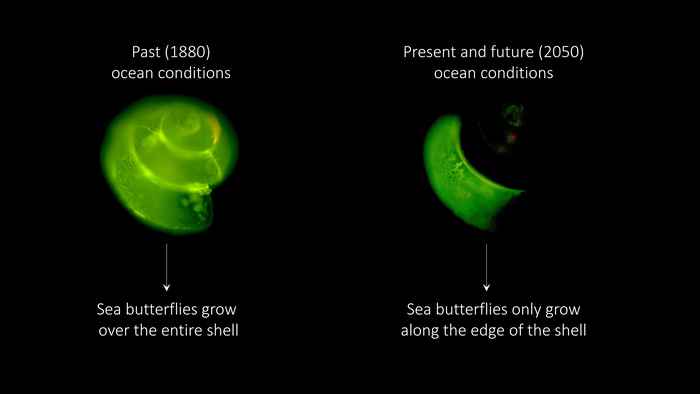Sea butterflies already struggle in acidifying Southern Ocean
4 March 2021

The oceans are becoming more acidic because of the rapid release of carbon dioxide (CO2) caused by anthropogenic (human) activities, such as burning of fossil fuels. So far, the oceans have taken up around 30% of all anthropogenic CO2 released to the atmosphere. The continuous increase of CO2 has a substantial effect on ocean chemistry because CO2 reacts with water and carbonate molecules. This process, called ‘ocean acidification’, lowers pH, and calcium carbonate becomes less available. This is a problem for calcifying organisms, such as corals and molluscs, that use calcium carbonate as the main building blocks of their exoskeleton.
Sea butterflies
In particular, organisms that build their shells from a type of calcium carbonate known as ‘aragonite’ are in trouble because aragonite is extremely soluble in sea water. Sea butterflies, tiny, swimming sea snails, build their shells of aragonite. Therefore, they are also known as ‘the canaries of the coalmine’ because they are expected to be amongst the first organisms to be affected by ocean acidification.
The Southern Ocean, around the Antarctic continent, is a region of high concern regarding ocean acidification. Globally, this region will experience acidified conditions first, because colder waters take up CO2 more readily. This is comparable to soda: you will find more bubbles dissolved in your soda when it is cold. Already within several decades, aragonite will be scarce in the Southern Ocean, posing a large problem for local sea life, such as sea butterflies.
Ocean food web
Large numbers of sea butterflies inhabit the Southern Ocean and function as an important component of the food web where they are eaten by fish, seabirds and even whales. 'It is important to gain a deeper understanding of the impacts of an increasingly acidifying ocean on the shell growth of sea butterflies', says Lisette Mekkes, PhD candidate at Naturalis Biodiversity Center and the UvA Institute for Biodiversity and Ecosystem Dynamics. 'Imagine that a highly abundant sea butterfly, Limacina retroversa, disappears from this region; that would have major implications for the rest of local sea life that depend on them for food, and for the calcium carbonate export from surface waters to the deep sea.'

As part of Lisette’s PhD research, sea butterflies from the Southern Ocean were exposed to different ocean conditions comparable to the past, the present and the near-future. Through a green, fluorescing substance, shell growth of the sea butterflies was visualized. Based on this fluorescing, the scientists discovered that sea butterflies already experience difficulties in building their shells in today’s Southern Ocean. This will become even more difficult in the upcoming decades.
Calcification
In past conditions, equivalent to the year 1880 (before an increased concentration of CO2 was absorbed by the oceans) sea butterflies were able to calcify over their entire shell: they built thicker and larger shells. In the present-day and future ocean conditions, sea butterflies mostly built more shell material only along the edge of the shell. Moreover, shells exposed to the future conditions did not increase in shell weight and had a lower density compared to past and present conditions, suggesting that calcification will be further compromised in the future.
'It appears that sea butterflies change their calcification strategy as a consequence of ocean acidification' explains Katja Peijnenburg, group leader at Naturalis Biodiversity Center and the UvA Institute for Biodiversity and Ecosystem Dynamics. 'As long as the oceans are not acidifying, sea butterflies can invest in growing thicker and larger shells. However, when the oceans acidify and aragonite is less available, they invest mostly in becoming larger' concludes Peijnenburg.
Although it is generally known that sea butterflies are vulnerable to changes in ocean chemistry, it is alarming to find out that they are already experiencing difficulties building their shells in today's ocean. The scientists wonder how much longer sea butterflies will be able to build their shells as the global ocean continues to acidify.
Publication details
Lisette Mekkes, Guadalupe Sepúlveda-Rodríguez, Gintarė Bielkinaitė, Deborah Wall-Palmer, Geert-Jan A. Brummer, Linda K. Dämmer, Jef Huisman, Emiel van Loon, Willem Renema and Katja T. C. A. Peijnenburg: ‘Effects of ocean acidification on calcification of the sub-Antarctic pteropod Limacina retroversa’, in Frontiers in Marine Science (March 2021). DOI: https://doi.org/10.3389/fmars.2021.581432
